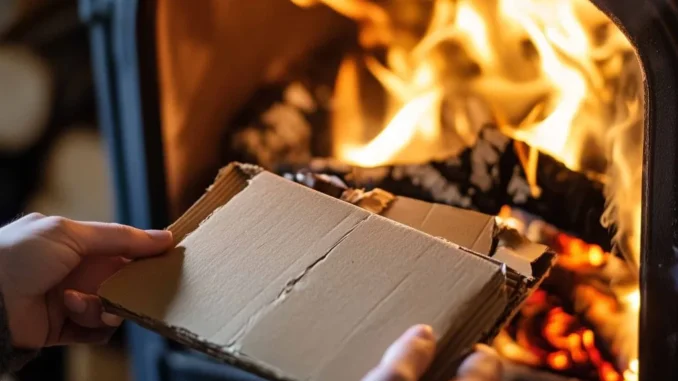
Cardboard is a ubiquitous material in our daily lives. We use it for packaging, moving boxes, and even DIY projects. But there’s a key question that often arises: can you burn cardboard? Is it a safe way to get rid of extra cardboard, or should you think twice before lighting a match? Whether you’re looking for an easy disposal method or wondering about the environmental impact, it’s crucial to understand the risks and benefits. In this article, we’ll examine all aspects of burning cardboard, from the science behind it to the potential dangers, best practices, and safer alternatives.
The Science of Cardboard: What’s Inside and How It Burns
To answer the burning question, it’s important to know what makes cardboard so flammable in the first place. So, can cardboard be burned? Yes, but let’s explore why it catches fire so easily and how it burns.
What Makes Cardboard Flammable?
Cardboard consists primarily of paper pulp, which is naturally combustible. When you expose it to a flame, the heat causes the paper fibers to break down, releasing gases that fuel the fire. The flammable properties of cardboard make it an easy target for ignition. The glue used to bind the layers together adds another layer of flammability. Can cardboard be safely burned? While it’s possible, knowing the types of cardboard and the conditions is key to ensuring safety.
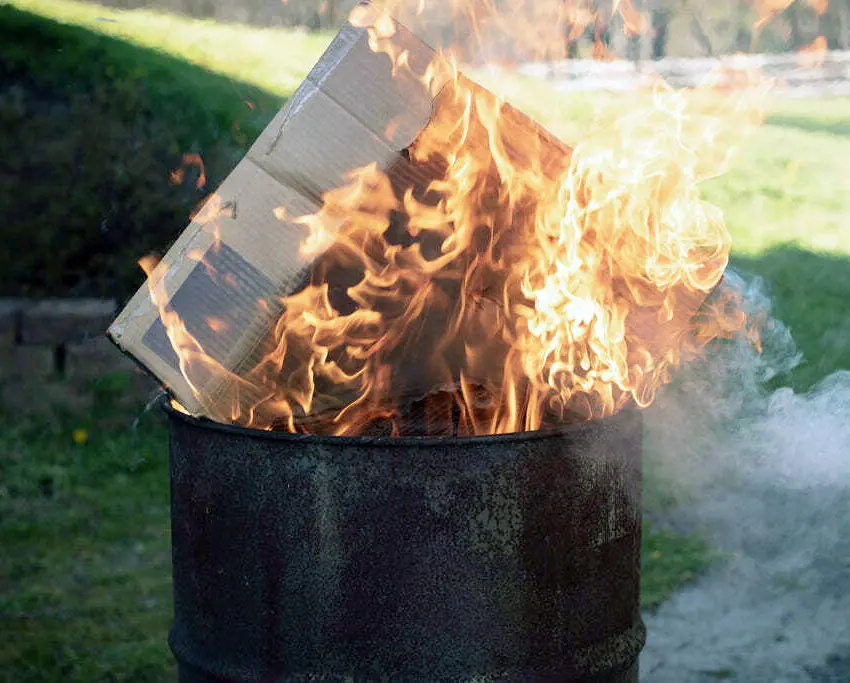
The Ignition Point and How Cardboard Burns
Cardboard’s ignition point typically falls between 450°F and 500°F (232°C to 260°C). Under dry conditions, it catches fire quickly and burns at a rapid pace. The burning process releases a significant amount of heat, which can be dangerous in certain settings. The structure of cardboard also contributes to the speed of combustion — its layers catch fire easily, and the fire spreads quickly. If you’re thinking, can you set cardboard on fire at home, keep in mind that its quick burn time may not give you much control over the fire.
The Environmental Impact of Burning Cardboard
Before deciding to burn cardboard, it’s essential to consider the environmental effects. Can cardboard be burned without causing harm? When cardboard is burned, it releases pollutants into the air, including particulate matter. These fine particles can contribute to air pollution and can have negative effects on your health, especially in areas with poor air quality. Furthermore, burning cardboard that has been printed or coated with inks or plastics can release toxic fumes. These chemicals can have long-lasting environmental impacts, contributing to air and soil pollution.
When Is Burning Cardboard Safe?
While burning cardboard is not always advisable, there are specific conditions under which it may be safe. So, is it safe to burn cardboard? Let’s break down the circumstances where burning might be considered acceptable.
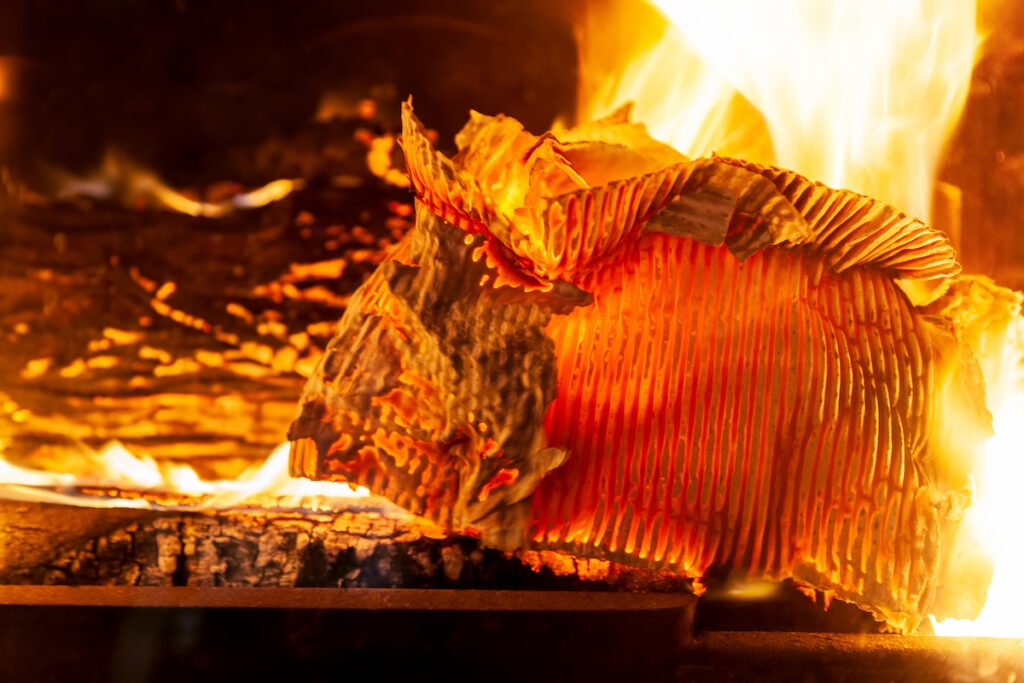
Outdoor Burning: Controlled Environments Like Fire Pits or Bonfires
One of the safest ways to burn cardboard is in a controlled, open outdoor environment. This could be a fire pit, a bonfire, or a designated burning area. These spaces are designed to contain the fire and prevent it from spreading. Can cardboard be incinerated in a fire pit? Yes, but only if it is done responsibly. It’s crucial to choose a location that’s free from nearby structures, trees, or other flammable materials. This ensures that the fire remains contained, reducing the risk of accidents. If you’re planning to burn cardboard, make sure the fire is manageable and always monitor it closely.
Burning in Fireplaces or Wood Stoves
Using a fireplace or wood stove to burn cardboard is generally not a good idea. While cardboard can be burned, these systems are designed to handle wood, not paper or cardboard. Burning cardboard inside a fireplace or stove can create a buildup of creosote in the chimney, which increases the risk of a chimney fire. Can you burn cardboard in a fireplace safely? In most cases, it’s not recommended. The materials in cardboard can also cause excessive smoke, which can be unpleasant and potentially harmful to breathe in. Stick to more open, controlled outdoor areas when considering burning cardboard.
Types of Cardboard That Are Less Harmful to Burn
Not all cardboard is created equal, and the type of cardboard you burn can make a difference in the safety of the process. Can cardboard be burned safely? The answer is yes, but only certain types of cardboard are less harmful to burn. Plain, uncoated cardboard, like the kind used for moving boxes, is generally safer to burn. On the other hand, cardboard that is coated with plastic, wax, or ink should be avoided, as these materials can release harmful chemicals when burned. Always check your cardboard before deciding to burn it.
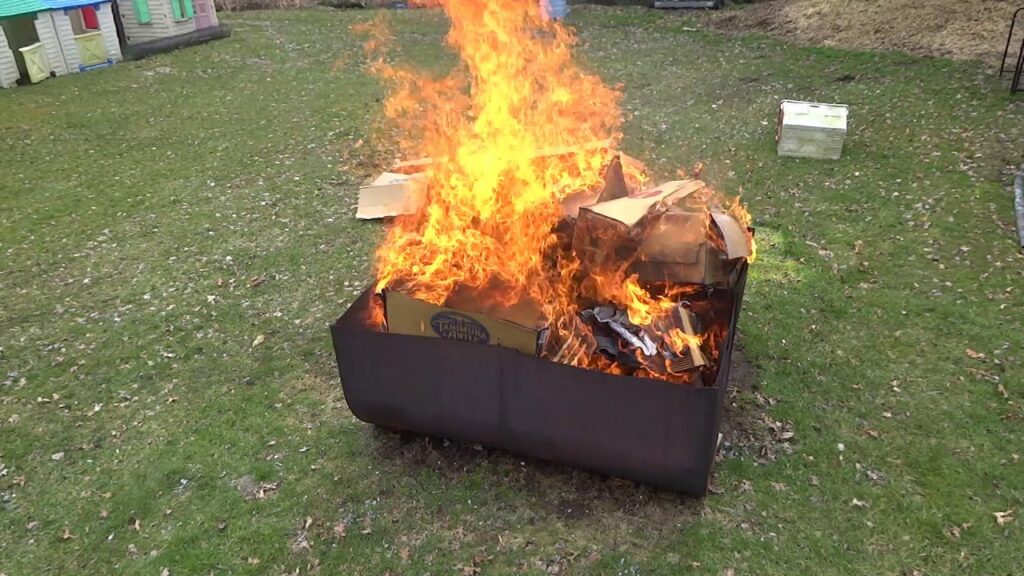
The Dangers of Burning Cardboard: Why You Might Want to Think Twice
Even though burning cardboard may seem like an easy way to dispose of it, there are significant risks involved. Can you safely burn cardboard in every situation? Not necessarily. Let’s explore some of the dangers you need to be aware of.
Toxic Fumes: What Chemicals Are Released When Burning Cardboard?
When cardboard is burned, particularly those types that are printed or coated, harmful chemicals are often released. These chemicals can include volatile organic compounds (VOCs), carbon monoxide, and dioxins. Can you burn cardboard safely with these materials present? The answer is no. These chemicals pose a serious threat to both human health and the environment. Inhalation of these toxic fumes can cause respiratory issues, headaches, and dizziness, particularly if the burning is done in an enclosed or poorly ventilated space.
Air Pollution: How Burning Cardboard Contributes to Environmental Harm
The air pollution caused by burning cardboard can have long-lasting effects. Is burning cardboard allowed in certain areas due to air quality concerns? In some regions, the practice is banned or highly regulated to reduce air pollution. The release of particulate matter into the atmosphere is harmful to both humans and wildlife. Even if you’re burning cardboard in a relatively remote area, the particles can travel and affect nearby communities. Additionally, these pollutants can affect the quality of soil and water over time, contributing to broader environmental damage.
The Risk of Fire Spreading or Creating a Fire Hazard
Another major risk when burning cardboard is the possibility of the fire getting out of control. Can cardboard be burned safely if the conditions aren’t perfect? Not necessarily. Cardboard is lightweight and easily carried by the wind, which can spread the fire beyond its intended location. If the fire isn’t contained properly, it could ignite surrounding vegetation, structures, or other materials. Always ensure you have a safe area to burn cardboard and take precautions to prevent the fire from spreading. Keeping a hose or a fire extinguisher nearby is always a good idea.
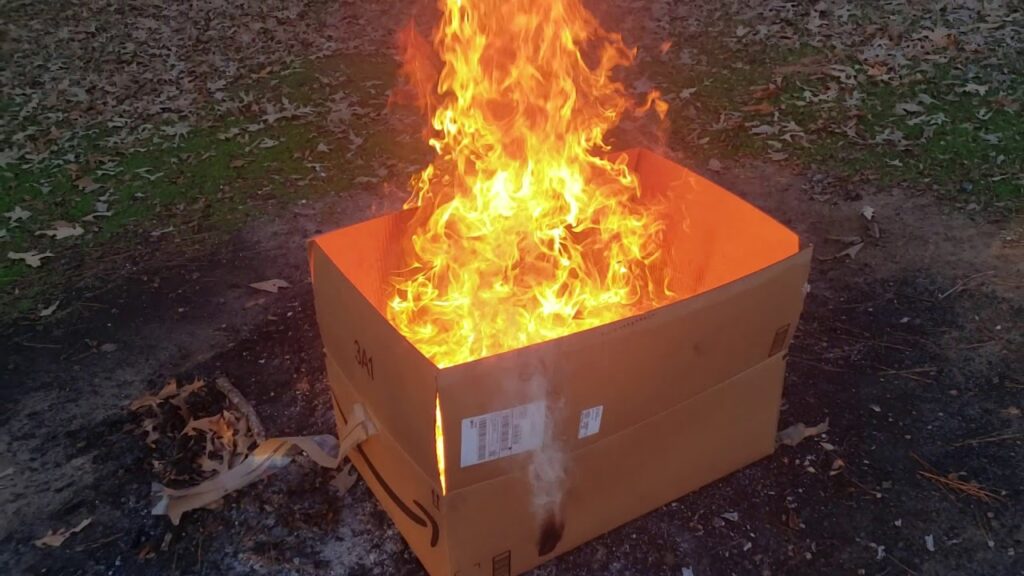
How to Safely Burn Cardboard: Best Practices for Safety and Health
If you’ve decided that burning cardboard is the best option for you, it’s crucial to follow best practices to ensure that it’s done safely. Can cardboard be used as fuel? Yes, but it must be burned under specific conditions. Let’s look at the best ways to safely burn cardboard.
Choosing the Right Location for Safe Burning
The first step in safely burning cardboard is to choose the right location. This should be a wide-open space away from any buildings, trees, or other flammable materials. Can cardboard be burned in an area that’s not well-ventilated? It’s better not to. Make sure the location allows for proper air circulation, as this helps reduce the buildup of harmful fumes. Ideally, you should burn cardboard in a fire pit, a designated burning area, or an outdoor barbecue that is intended for open flames.
Ensuring Proper Ventilation to Avoid Inhaling Harmful Fumes
When burning cardboard, ventilation is critical. Can cardboard be burned safely in a confined space? It’s best not to. Inhaling the toxic fumes produced by burning cardboard can cause serious health problems. Ensure that the burning area is open and well-ventilated, allowing smoke to disperse and reducing the concentration of harmful particles. If you are burning cardboard outdoors, make sure the wind isn’t blowing smoke in your direction.
Proper Disposal of Packaging Materials Before Burning
Before you burn any cardboard, make sure it’s free of any non-cardboard materials such as tape, labels, or stickers. Can cardboard be burned safely if it still contains plastic or metal? No, these materials can release dangerous chemicals when exposed to heat. Remove any packaging materials before starting the fire. This ensures that the cardboard itself is the only material burning, minimizing the release of harmful substances into the air.
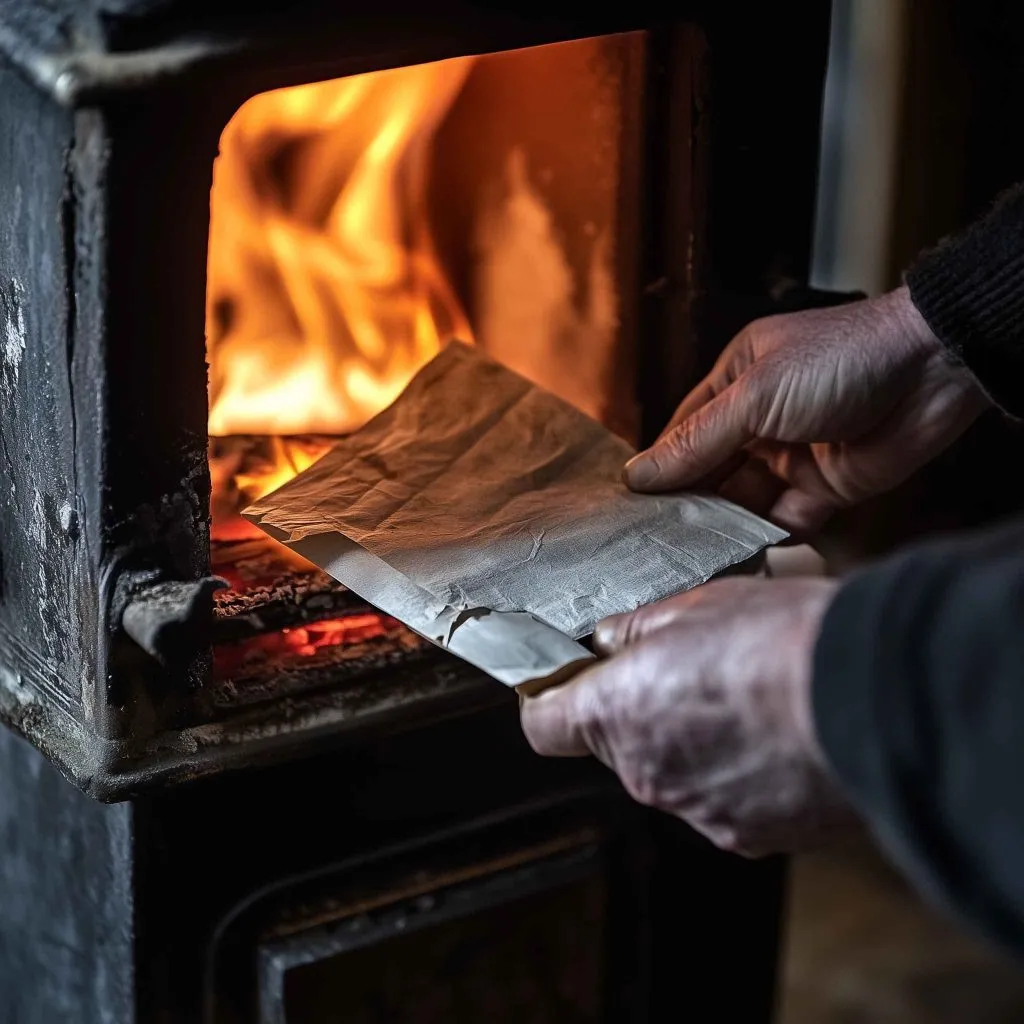
Alternatives to Burning Cardboard: Better Ways to Recycle or Dispose of It
If burning cardboard seems too risky or harmful, there are several alternatives. Can cardboard be burned, or is there a better way to handle it? In most cases, recycling, reusing, or composting cardboard is a more environmentally friendly option.
Recycling: How to Prepare Cardboard for Recycling
The most eco-friendly option for disposing of cardboard is recycling. Can you recycle cardboard? Absolutely! Just flatten the cardboard, remove any non-cardboard materials, and take it to your local recycling center. Many communities have curbside recycling services that make it easy to dispose of cardboard responsibly. If you are wondering how to prepare cardboard for recycling, it’s as simple as breaking it down into manageable pieces and ensuring it’s free from contaminants like food, grease, or plastic.
Reuse: Creative Ways to Repurpose Cardboard for Crafts or DIY Projects
Another great way to keep cardboard out of the landfill is by reusing it. You can turn old boxes into creative projects, such as storage bins, wall art, or even furniture. Can you set cardboard on fire in this case? If you’re repurposing cardboard, burning it may not be necessary at all. Reuse it for your next DIY project, and you’ll be saving resources while keeping waste out of the trash.
Composting: Can Cardboard Be Composted, and If So, How?
Cardboard can also be composted, making it an excellent addition to your garden. Can cardboard be composted? Yes, but you need to break it down into smaller pieces before adding it to your compost pile. This allows microorganisms to break it down faster. Cardboard provides carbon, which is essential for healthy compost. Just make sure the cardboard is free of inks and other coatings before adding it to your compost.
Legal Considerations: Is Burning Cardboard Allowed Where You Live?
Before you set fire to that cardboard, check the local regulations. Can cardboard be burned legally where you live? In some areas, burning cardboard may be illegal or restricted due to fire safety or air quality concerns.
Fire Bans or Restrictions to Be Aware Of
In many regions, fire bans are enacted during dry seasons to prevent wildfires. Is it okay to burn cardboard in such areas? No, fire bans prohibit any kind of outdoor burning, including cardboard. Always check with your local fire department or government authorities before lighting any fire, especially during peak wildfire seasons.
Penalties for Improper Burning Practices
Improper burning of cardboard can lead to significant penalties. Can you face fines for burning cardboard improperly? Yes, in many places, illegal burning can result in hefty fines or even criminal charges. Always be aware of the rules in your area to avoid unwanted legal consequences.
Final Thoughts: Should You Burn Cardboard?
So, can you burn cardboard? The answer depends on several factors, including the type of cardboard, where you’re burning it, and local regulations. While burning cardboard can be done safely in certain conditions, the risks — such as air pollution, fire hazards, and toxic fumes — should not be ignored. Recycling, reusing, and composting are safer and more eco-friendly alternatives. Consider your options carefully before deciding whether to burn that cardboard pile.